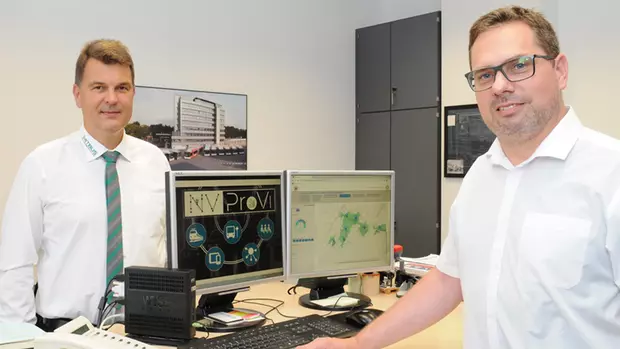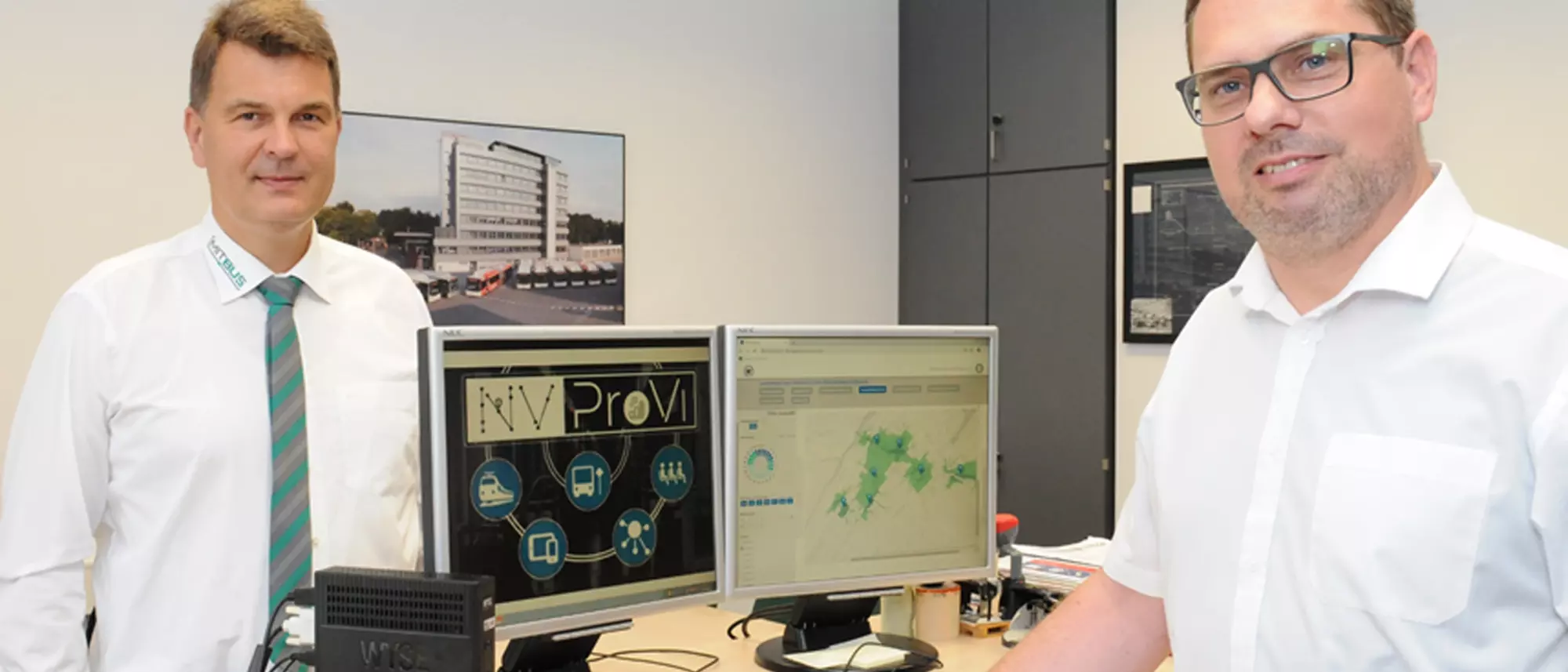
Stadtwerke Gießen and Brodtmann Consulting are currently working on a pioneering local transport project with the support of SWG's local transport subsidiary MIT.BUS. The Rhein-Main-Verkehrsverbund (RMV) is supporting the project as an associated partner. The main aim is to provide passengers with useful information in real time. The Federal Ministry of Transport and Digital Infrastructure is funding the project due to its great potential.
Being able to see on your smartphone exactly when the bus is coming, how full it is and whether there is still room for a pushchair - this will soon be a reality in Giessen. Transport specialists from Stadtwerke Gießen (SWG) and its local transport subsidiary MIT.BUS as well as the data analytics experts from Brodtmann Consulting are currently working together on the NV-ProVi project with the support of RMV. In contrast to the abstract working title, the expected benefits for passengers are very concrete. In fact, smart algorithms are set to revolutionise the information system of the Rhine-Main Transport Association in the near future. "NV-ProVi is the first big data project in the SWG Group," says Jens Schmidt, Commercial Director of SWG.
The partners involved are pursuing several goals with this outstanding project. The primary aim is to provide passengers with helpful data that makes the use of local public transport more convenient and therefore more attractive. This requires two things: more passenger counting sensors in the MIT.BUS vehicles and functioning interfaces that can be used to merge the various data. At SWG and MIT.BUS, the focus is naturally on the installation of additional counting systems. Because: "The more real data we can collect, the more accurate the forecasts will be," explains Matthias Funk, Technical Director at SWG.
Another important project objective is the development of a model that forecasts key figures relevant to public transport - especially with regard to occupancy and timetable adherence. State-of-the-art technologies such as machine learning and artificial intelligence are being used to achieve this. "We are certainly starting with established approaches, but we are also convinced that the integration of real-time data in particular will open up completely new paths in AI-based forecasting in public transport, which we will tackle both scientifically and in a practice-oriented manner," explains Marc Lammerding, Partner for IT and digitalisation at Brodtmann Consulting and overall project manager of the NV-ProVi project. Last but not least, the project partners also want to make a real contribution to the scientific discussion on the use of these analysis methods in public transport.
Better public transport - less CO2
Buses and trains are seen as important factors in the transport transition. Especially here in Giessen, where the city buses have been running on bio natural gas for almost a year and a half and are practically CO2-neutral. "The project is a big step forward on our path to becoming a climate-neutral municipality," says city councillor Gerda Weigel-Greilich. And SWG Supervisory Board Chairwoman Astrid Eibelshäuser adds: "Few municipalities have such committed partners when it comes to climate protection." In fact, local transport services and transport-related CO2 emissions have a direct impact on each other. "The more attractive and the more predictable a connection is, the more likely people are to leave their cars at home and use the bus," says Mathias Carl, Managing Director of MIT.BUS.
Because an extremely large number of components have to function reliably in a very complex interaction, it will still take a while and many a test run before the data can be imported into the free RMV app and on the RMV website in the so-called live map on the smartphone. The experts involved in the project expect to be receiving real-time data constantly before the end of this year. "We currently assume that we will be able to supply the RMV app with live data in 2022," explains Jens Schmidt. There is still a lot to do before then - such as consistently equipping the buses with passenger counting sensors and a lot of work in the development of AI-based algorithms.
"Forecasting capacity utilisation in local transport is a highly complex issue, but an urgent one, especially due to coronavirus," says Prof. Knut Ringat, Managing Director of the Rhein-Main-Verkehrsverbund. "The project of our Giessen partners is an ideal fit for the RMV digital strategy and we look forward to incorporating the data collected here into our network-wide capacity utilisation forecast."
Funded due to great potential
The people behind the project are already exploring what other potential applications exist - with other local transport providers, but also with the scientific community. Because the fact is: NV-ProVi is likely to be of great interest beyond Giessen's borders. "Other local authorities are facing very similar problems," says Matthias Funk. It is precisely this fact that is the decisive reason why SWG and Brodtmann Consulting have received funding totalling 354,418 euros from the Federal Ministry of Transport and Digital Infrastructure. The funds come from the mFUND research initiative and are only awarded to selected projects after rigorous scrutiny.
The idea of digitally optimising local transport is not entirely new. The nucleus of the current project is a hackathon organised by the Association of Municipal Enterprises in 2018, where dedicated computer specialists meet to write useful programs together. At the time, Jens Schmidt described the problem of congestion times in Giessen's bus service and asked for a visualisation. The hackers provided him with exactly that. And this led to more: the Vectura Analytics project. The analysis tool developed by Brodtmann Consulting in collaboration with SWG now processes around 10.3 million data records that have been collected since December 2018 - in over 475,000 journeys, 75,000 of them with passenger counting systems. The software provides visualised information on journey time profiles, passenger numbers and capacities, on routes and the accessibility of stops, on the quality of the data itself and, last but not least, on the optimisation of the passenger counting systems. "Intelligent, dynamic visualisation of the analyses created from the raw data is a key success factor in order to be able to precisely identify and react to overarching patterns and trends," explains Marc Lammerding. "Differentiated filters can also be used to precisely record the effects of exceptional situations such as the current COVID-19 pandemic on local transport and analyse them down to a single journey - this helps to be able to react as accurately and flexibly as possible." Consequently, Brodtmann Consulting and SWG with MIT.BUS laid the ideal foundation for the current work on the NV-ProVi funding project in the Vectura Analytics project.

